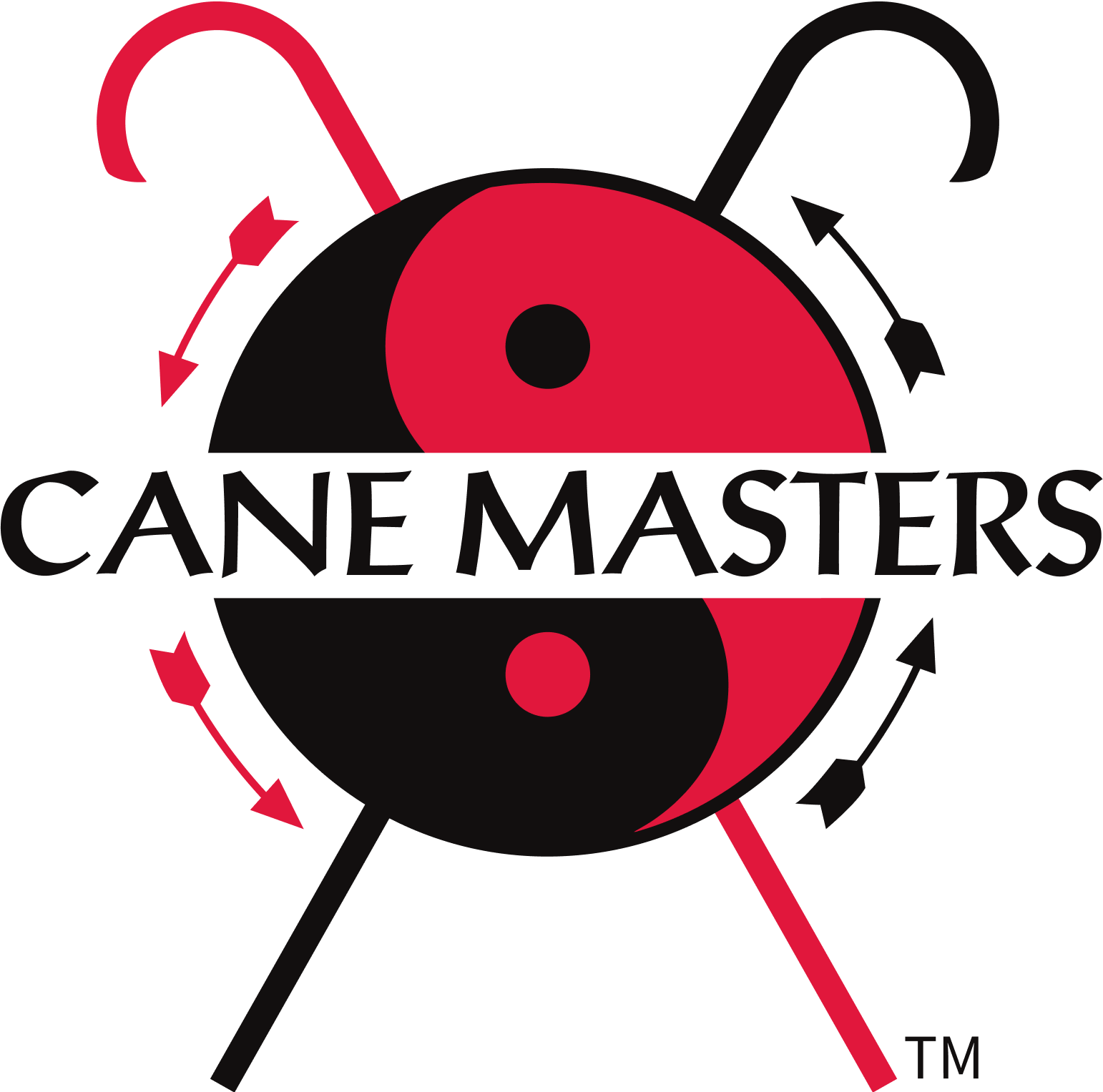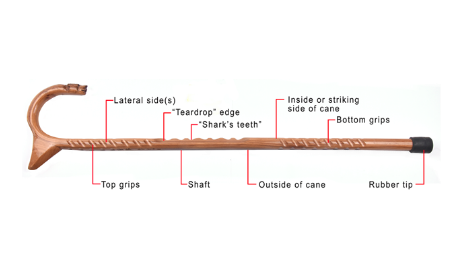Bantam: A short (32” or four inches less than your normal length) cane that qualifies as a mobility tool while excelling as a personal protection device. The shorter length makes the cane ideal for travel and maneuverability. Bantam canes can be quickly stored in the overhead bin of an aircraft cabin, positioned adjacent to the console in your auto, or carried into a restaurant.
Cane (walking): an ambulatory tool, most often with a “J-shape” top, designed to redistribute weight from a hip, knee, or leg, improve stability by increasing the base of support, and provide tactile information about the ground to improve balance. A cane may also be used for fashion, exercise, and self-defense.
Cudgel: A short heavy club that is not intended for ambulatory purposes. (see Shillelagh)
Copper tip: (see Ferrule) Cane Masters LLC uses pure copper ferrules with replaceable rubber tips for durability, traction, and appearance.
Crook: The inverted “J-shape” at the top of a cane that is often used as a hook or handle. The shape evolved from the design of a shepherd’s crook and is the world’s most popular cane style. The crook allows the cane to be quickly draped over a user’s arm while shopping or hooked into a waist belt. The crook may be held with either hand, and should be carried with the horn facing forward.
Derby handle: A flat top handle that resembles the Fritz, except that the end of the handle is rounded. Derby handles are often carried by individuals as a fashion accessory. The design of the cane, and the absence of the “J-shape” makes it less desirable for personal protection.
Drugstore cane: A lightweight and inexpensive cane frequently sold in drugstores and discount stores. Such canes are usually made of thin aluminum and considered unreliable for either dependability or personal protection.
Ferrule: A metal sleeve at the tip of a cane that prevents the wood from splitting or wearing. The bottom of the ferrule is covered in rubber. While providing strength to the tip of a cane shaft, a ferrule is sometimes seen as a fashion accessory.
Fritz handle: A style that became popular in Germany in the 18th century and is noted for its flat top. The flat top is sometimes preferred for individuals with advanced arthritis. The design of the cane, and the absence of the “J-shape” makes it less desirable for personal protection.
Glass-breaker: A metal stud inserted into the tip of a cane (or palm rest) for breaking glass and escaping a flooding automobile.
Grips: Notches cut into the shaft to allow the user to hold the cane securely with the fingers and palm. Grips may be cut into the top, middle, and bottom of the cane shaft, as well as the crook and horn.
Hiking staff: A single pole that is most effective when walking on level terrain and with little or no load on your back. It does not qualify as a mobility device and has limited application for personal protection.
Horn: The short end of the crook of a cane. The tip of the horn may be carved or shaped for aesthetics or personal protection. The tip of the horn can be blunt (soft) or formed into a point (sharp). 
Inside: The side of the shaft beneath the crook and closest to the horn.
Lateral side: Either side of the cane shaft.
Leading edge: The lower (or outer) edge of a palm rest.
Mini-cane: A shortened 24-inch cane that is useful for training or carrying in an automobile as an emergency escape tool. Mini-canes are also used (singly or in pairs) to increase ambidexterity and master complex two-cane movements.
Mouth: The distance between the inside of the horn and the inside of the cane shaft. In commercial “drugstore” canes this distance is usually 3 - 3.5 inches. Cane Master canes are produced with “mouths” of approximately 4.5 inches. The additional width of the mouth allows the cane to be maneuvered for a variety of self-defense movements.
Octagonal shaft: An eight-sided cane shaft.
Outside: The reverse side of the cane shaft opposite the side of the cane with the horn.
Palm Rest: An additional piece of wood added to the outside top of a cane to provide additional support for your palm. It is especially useful when walking long distances with the cane in a horn forward position. For defensive purposes the palm rest may be used to strike and incapacitate an attacker to provide you with enough time to retreat and contact the authorities. Crafting a palm rest requires 2-3 hours of skilled labor. The palm rest is mounted to the cane shaft with a series of “blind dowels” and bonded with an industrial strength adhesive. The resulting joint for the palm rest becomes the strongest part of the cane.
Point: The tip of the palm rest may be used for defensive purposes, or in the world of Covid-19, for opening doors and pressing elevator buttons, buzzers, etc.
Rubber tip: A replaceable rubber cap for the cane tip that is designed to increase skid-resistance and help prevent falls.
Rumble strip: A series of shallow notches placed at right-angles along the shaft of the cane and useful defensively for raking the hand or arm of an attacker.
Samurai cane: A cane with a shaft that has been crafted into a teardrop shape to create a long striking edge. In addition to its primary use as a mobility device, it can be maneuvered defensively using two handed techniques designed by Japanese sword masters.
Shaft: The long part of the cane. Dependable cane shafts are most often made of solid wood, but sometimes with aircraft grade aluminum. Collapsible canes or those that disassemble into parts, generally lack the necessary strength and structural stability for ambulatory needs or personal protection and are not recommended.
Shark’s teeth: Serrations or notches cut into a Teardrop Edge for defensive use to rake the hand or arm of an attacker.
Shillelagh: A wooden club or cudgel typically made from a stout blackthorn (or Oak) stick with a large knob on the top. It is widely associated with Ireland and Irish folklore. Lengths are usually that of a three-foot walking stick but may be as long as 4-5 feet in length. Sometimes the large knot on the end of the stick is filled with molten lead to increase its striking power. Shillelaghs are not considered to be ambulatory tools.
Striking edge: A 2-3 inch section at the top of the cane (opposite the horn) that has been crafted to create an edge. As with the Teardrop Edge, the force of a cane blow is concentrated along the edge to increase the impact of the strike.
Tactical cane: A mobility cane that, if necessary, can be wielded defensively with skill and cunning.
Teardrop edge: A section of the cane shaft that has been machined to create a V-shaped striking edge. By removing the surrounding wood, the force of a strike is magnified and concentrated along the narrow striking edge.
Tip: The end of the cane that is in contact with the ground when using as an ambulatory aid.
Valley: The low point between the crown of the horn and the outer edge of a palm rest. The base of your palm should nestle comfortably into the Valley when you are walking with the horn facing forward.
Walking sticks: A temporary device, such as a denuded branch of a tree, used for stability or balance when walking or climbing on rough terrains.
Please call us at Cane Masters LLC, 1-800-422-CANE (2263), if you have further questions or would like assistance with ordering a cane.


Share:
Use Your Walking Cane for Home-Defense
How to Properly Measure and Size Your Cane